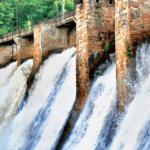Nepal’s population is known to be a fairly young one, with a median age of 21.6 years according to the 2011 census – however, this population is soon to get old, without much changing in and around the country.
In the past few decades, Nepal has been experiencing rapid demographic changes. As the country continues to transition from high-mortality and high-fertility to low-mortality and low-fertility, the population structure will continue to see dramatic changes.
Below given figure shows the projected demographic structure of Nepal in 2050, as compared to what it was in 2015.

Source: Demographic Changes of Nepal, National Planning Commission
Nepal is transitioning towards an ageing and an aged Society
Based on the report “Demographic Changes of Nepal: Trends and Policy Implications” by the National Planning Commission and UNICEF, Nepal will become an ageing society by 2028 and an aged society by 2054. An ageing society is defined as one with at least 7 percent or more of the total population aged 65 or above. Similarly, an aged society is one where the total percentage of the population aged 65 or above becomes 14 percent or more.
Therefore, Nepal has very less time to take advantage of the demographic window. Also, the rapid progress of the ageing society and shrinking demographic window of opportunity will also be Nepal’s biggest challenge for the next few decades. In addition, if Nepal’s development goals are not fulfilled by 2054, as Nepal will transition into an aged society by then – the population will have gotten old before seeing Nepal develop.
Moreover, this transition will also increase the number of dependent people. People aged 65 or above are generally known as “old-age dependents”; due to which, when their population increases the overall potential support ratio goes up. Similar can also be said about dependent children, however, they transition into working-age population after the age of 14. In the near future, the country’s working-age population (15-64 years) is expected to increase relative to the dependent children and elderly population. But, population estimates suggest that this window of opportunity will not be there for long. In 2015, the potential support ratio was 11.6 working-age people per elderly person i.e. there were around 11.6 working-age people supporting one elderly person. This ratio is projected to become 5.6 working-age people per elderly person by 2050 and 1.6 working-age people per elderly person by 2100.

Figure 2: Nepal potential support ratio: 2000-2100 (Number of working-age adults supporting one old-age dependent)
Source: Demographic Changes of Nepal, National Planning Commission
Failures have become normalized
When the current ruling Communist Party of Nepal (then, two separate parties – CPN UML and Maoist Center) unveiled their election manifesto, there were great expectations from them. The manifesto had incorporated various popular programs including social security, various development projects, programs related to economic growth and strengthening nationalism, etc. The manifesto also covered modern train services, trams, waterways, megacities, etc. When the Communist Party of Nepal won with an almost two-thirds majority in the parliament, all stakeholder and also the general public expressed their delight. At the time, everyone had felt that political instability was soon to become history, and we would now move into a new narrative of economic growth. Fast forward to three years – the political war still continues, the government with a two-thirds majority has proven to be no better when compared to the unstable governments of the past, and policies still lack stability and proper implementation. Furthermore, the members of the ruling party are themselves antagonistic to their own government.
Political instability was long blamed to be the cause of the fallouts in developmental works, but the rhythm is still missing even with it. Amidst the ongoings, the blames is sometimes shifted to the parliamentarian system, where there have been claims made that a system with a directly-elected head of state is the way to go. Even with the general public, there seems to be no urgency. People are fine with what has been going around and with the government abdicating its responsibilities, as they enjoy a few political bytes (caused by political tensions) from time to time. Furthermore, in the current scenario, one can find numerous ways to blame just about everyone for the lackluster handling of developmental works. But, this will do very little to help the country make progress.
The lackluster handling is no exception even for the national pride projects. The very name “National Pride Project” depicts its importance, as these are those projects which are crucial for the development of the country. However, when one looks at the current state of these projects, they go in an absolute state of despair. Most of the national pride projects have been put into action for more than a decade. Projects like Babai Irrigation Project and Melamchi Water Supply Project have become anecdotes for Nepal’s development rhetoric. Bheri-Babai Irrigation Project was announced 33 years ago (in 1987 AD) and Melamchi Drinking Water Project was announced 20 years ago (in 2000 AD). Projects like West-Seti Hydropower Project couldn’t take off even 22 years after its inception. The time and cost overrun in such projects have become a ‘development culture’ in the country.
In this way, failures have become normalized, and it seems highly unlikely that Nepal would reach to any extra-ordinary feat by 2054 (i.e. when Nepal becomes an aged society).
Transitioning from foreign employment to domestic employment is a herculean task
Nepali youths have always been lured to foreign employment. While youths from good financial backgrounds scout for education and work in countries like the United States of America and other countries in Europe, youths from poor financial and educational backgrounds have no other option than to go to countries like Malaysia and countries in the Middle-East.
Even with various economic tensions and the COVID-19 pandemic in the fiscal year 2019/20, a total of 193,880 Nepalis went out for foreign employment whereas a total of 175,553 Nepalis renewed their labor permits. All of this is very worrying as youths who could have stayed in Nepal and contributed to Nepal’s economy are outside contributing to some other country’s development goals.
 Figure 3: Total number of Nepalis going for foreign employment and renewing labor permits
Figure 3: Total number of Nepalis going for foreign employment and renewing labor permits
Source: Department of Foreign Employment
In addition, another aspect to worry about is the country’s dependence on remittance. Even in the COVID-19 struck fiscal year of 2019/20, Nepal received a remittance of NPR 774.87 billion in eleven months. Due to this, bringing back Nepalis has become even more difficult. If Nepalis, in large numbers, decide to come back to Nepal, the remittance inflow might drastically go down causing fiscal tensions; which is something that political parties would generally want to avoid. Furthermore, the level of unemployment might also rise due to the lack of proper and meaningful jobs for returnee migrant workers. Therefore, the transition from foreign employment to domestic employment might take a lot more than just promoting domestic employment, due to the risks associated with it.
 Figure 4: Total remittance received (In billion NPR)
Figure 4: Total remittance received (In billion NPR)
Source: Nepal Rastra Bank
How COVID-19 became a lost opportunity?
The COVID-19 pandemic and the lockdown was a great opportunity to transition from foreign employment to domestic employment. Nepalis were wanting to return to Nepal in large numbers, ostensibly because they had either lost their jobs abroad or because they were feeling unsafe there. In countries like Kuwait, UAE and Bahrain, official figures have shown that nearly all cases identified have been amongst foreigners, who were mostly living in labor camps. Many countries were also a bit hostile to migrant workers, sending them back to their home countries. Qatar’s move to deport Nepali workers on 15 and 19 March 2020 under the pretext of testing them for the COVID-19 is one such incident. Nevertheless, what all of these incidents did was motivate Nepalis abroad to return to Nepal to do something in Nepal itself. Thus, a great opportunity for transitioning to domestic employment was created.
Moreover, as tough times do leave behind a lot of lessons, similar was expected from the COVID-19 pandemic. The pandemic could have brought in a wave of motivated Nepalis who had gone out for foreign employment to come back to make something out of themselves in Nepal. However, the hope for this has been standing on-the-edge. Instead of promoting domestic employment to those who returned, it looks like the government has become abrasive by looking to take the easy-way out by opting for foreign employment again. The Department of Foreign Employment started issuing permits to those who had come to Nepal amidst the pandemic and wanted to return back, even before the lockdown was lifted. In less than a week, more than 1,000 people had already taken such permits. On the other hand, even when the government – at different levels – have pledged to provide jobs and other income generating opportunities to returnee migrant workers; these workers are mostly unaware about the government’s programmes. A report entitled “A rapid assessment of migrant workers during the pandemic” showed that only 2 percent (out of the 625 surveyed migrant workers) knew how to access government announced schemes.
The lack of seriousness in communicating to the target groups and in implementing the programmes will do nothing more than drive youths, who could have stayed in Nepal and contributed to Nepal’s economy, to opt out for foreign employment. Thus, it will be a daunting task for Nepal to achieve all its development goals when its young population is abroad.
Ishan Bista is an MPA candidate with a concentration in Economic and Financial Policy at Cornell University. He previously graduated with a BBA degree from Kathmandu College of Management, Siam University with a major in Marketing and Branding. His keen interest and aspirations lie in the area of public policy and economics. He previously worked as a research fellow for Nepal Economic Forum.





